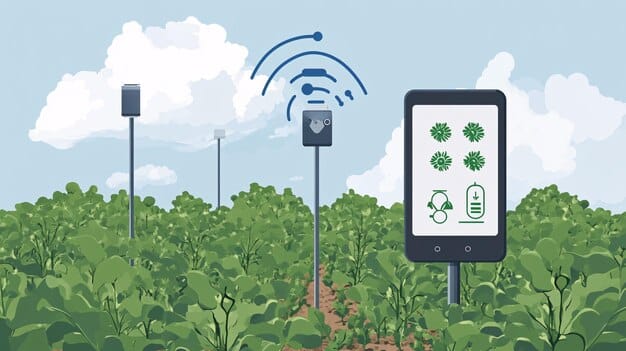The Role of Technology in Climate Change Solutions: A Sustainable Future

The role of technology in addressing climate change is pivotal, offering innovations like renewable energy systems, carbon capture technologies, and smart agriculture to mitigate greenhouse gas emissions and promote a sustainable future.
The urgency of climate change demands innovative solutions, and the role of technology in addressing climate change has never been more critical. From renewable energy to smart agriculture, technology offers a diverse range of tools to mitigate emissions and build a more sustainable future. Let’s delve into how these advancements are shaping our planet’s response to this global challenge.
Understanding the Critical Role of Technology in Addressing Climate Change
Climate change, driven by greenhouse gas emissions, poses an existential threat to our planet. The need for swift and effective action is undeniable, and the role of technology in addressing climate change is at the forefront of these efforts. But how exactly is technology helping us combat this global crisis?
Many technologies are currently deployed and in development that provide promise for significant impact. Investing in these technologies with aggressive policies and goals are paramount to success. Innovative technologies offer the capabilities for monitoring, understanding, and mitigating its effects.
Renewable Energy Sources
Renewable energy sources, such as solar, wind, and hydro power, are essential in replacing fossil fuels. These technologies significantly reduce carbon emissions and enhance overall energy sustainability. But how exactly are they transforming the energy sector?
- Solar Power: Solar panel technology has advanced rapidly, increasing efficiency and lowering costs. Large-scale solar farms and residential solar installations are becoming increasingly common.
- Wind Power: Wind turbines, both onshore and offshore, are harnessing the power of the wind to generate electricity. Technological improvements are making wind energy more reliable and cost-effective.
- Hydropower: Hydroelectric dams and other hydro power technologies utilize the energy of flowing water to produce electricity, providing a consistent renewable energy source.
The transition to renewable energy is not just an environmental imperative, it’s also an economic opportunity. Renewable energy projects create jobs, stimulate innovation, and enhance energy independence. Technological advancements are making renewable energy increasingly competitive with traditional fossil fuels.

Carbon Capture and Storage Technologies
Another facet of the role of technology in addressing climate change lies in carbon capture and storage (CCS) technologies. These methods aim to capture carbon dioxide emissions from industrial sources and store them underground, preventing them from entering the atmosphere. But how effective are these technologies in the fight against climate change?
CCS technologies involve capturing CO2 from power plants and industrial facilities, transporting it via pipelines, and injecting it into deep underground formations for permanent storage. This process can significantly reduce greenhouse gas emissions from major industrial sources.
Direct Air Capture
Direct Air Capture (DAC) is an innovative technology that removes CO2 directly from the atmosphere. DAC plants use chemical processes to capture CO2, which can then be stored or used in other applications. But how does DAC compare to other carbon capture methods?
- Scalability: DAC technology can be deployed anywhere, regardless of the location of emission sources, making it highly scalable.
- Permanence: Once captured, CO2 can be stored permanently underground, ensuring that it does not contribute to atmospheric warming.
- Applications: Captured CO2 can also be used in the production of fuels, plastics, and other valuable products.
Carbon capture and storage technologies are an essential tool in mitigating climate change, especially for industries that are difficult to decarbonize. While there are challenges associated with CCS, ongoing research and development are improving its efficiency and cost-effectiveness.
Precision and Efficiency: The Role of Smart Agriculture in Environmental Sustainability
Agriculture is a major contributor to greenhouse gas emissions, but technology offers solutions for more sustainable farming practices. Smart agriculture uses data, sensors, and automation to optimize resource use, reduce waste, and minimize environmental impact. What are the key components of smart agriculture?
Precision agriculture techniques involve using GPS, sensors, and data analytics to target inputs such as water, fertilizers, and pesticides precisely where they are needed. This approach reduces waste, lowers costs, and minimizes environmental harm. The role of data and technology allows precision applications increasing ROI.
Vertical Farming
Vertical farming involves growing crops in stacked layers within controlled indoor environments. This approach maximizes space utilization, reduces water consumption, and eliminates the need for pesticides. How is vertical farming revolutionizing urban agriculture?
The rise in AI and robotics will only further enhance the precision and efficiency capabilities. The promise if increased ROI while simultaneously reducing inputs makes the technology and economics promising.
- Reduced Land Use: Vertical farms require significantly less land than traditional agriculture, making them ideal for urban areas.
- Water Conservation: Closed-loop irrigation systems recycle water, reducing water consumption by up to 90%.
- Pesticide-Free: Controlled environments eliminate the need for pesticides, producing healthier and safer crops.
Smart agriculture technologies are transforming the way we grow food, making agriculture more efficient, sustainable, and resilient to climate change. By optimizing resource use and reducing waste, smart agriculture can help ensure food security while minimizing environmental impact.
Leveraging Data: How Sensor Technology and AI Drive Climate Solutions
Sensor technology and artificial intelligence (AI) play a crucial role in monitoring and managing climate change. These tools collect and analyze data to provide insights that inform decision-making, optimize resource use, and improve the effectiveness of climate mitigation and adaptation strategies. So, how are these technologies being applied in real-world scenarios?
Sensor networks can monitor air and water quality, track deforestation, and measure greenhouse gas emissions. AI algorithms can analyze this data to identify patterns, predict trends, and optimize responses to environmental challenges. This data-driven approach enables more informed and effective climate action.

Predictive Modeling
AI-powered predictive models can forecast the impacts of climate change, such as sea-level rise, extreme weather events, and changes in agricultural productivity. These models help communities and policymakers prepare for and adapt to the future impacts of climate change.
AI and sensor technology can only improve predictions with more data capture. The role of investment in the technology now will only improve forecasting capabilities in the near future.
- Early Warning Systems: AI can analyze weather patterns and environmental data to provide early warnings of extreme weather events, allowing communities to prepare and evacuate.
- Resource Management: AI can optimize the distribution of water and other resources, ensuring that they are used efficiently during droughts and other climate-related stresses.
- Policy Planning: Predictive models can inform policy decisions, helping governments and organizations develop effective strategies for climate mitigation and adaptation.
Sensor technology and AI are powerful tools for understanding and managing climate change. By providing real-time data, predictive insights, and decision-making support, these technologies can help us build a more resilient and sustainable future.
The Role of Technology in Addressing Climate Change: Innovations and Solutions for a Sustainable Future
The role of technology in addressing climate change: innovations and solutions for a sustainable future cannot be overstated. It is the convergence of ingenuity and necessity, as we harness technological advancements to confront one of the most pressing challenges of our time. By combining efforts and investments the ability to mitigate and adapt can only improve.
From renewable energy and carbon capture to smart agriculture and data analytics, technology provides a comprehensive toolkit for mitigating emissions and adapting to the impacts of climate change. However, realizing the full potential of these technologies requires concerted action. Governments, businesses, and individuals must collaborate to invest in research and development, deploy innovative solutions, and create policies that support a sustainable future.
| Key Aspect | Brief Description |
|---|---|
| ☀️ Renewable Energy | Replacing fossil fuels with solar, wind, and hydropower to reduce emissions. |
| 💨 Carbon Capture | Capturing CO2 from industrial sources and storing it underground. |
| 🌱 Smart Agriculture | Optimizing resources with data and automation for sustainable farming. |
| 📊 Sensor Technology & AI | Monitoring and predicting climate patterns for informed decision-making. |
Frequently Asked Questions
Technology reduces greenhouse gas emissions through renewable energy sources like solar and wind power, carbon capture technologies, and smart agriculture practices that optimize resource use.
CCS involves capturing carbon dioxide emissions from industrial sources and storing them underground, preventing them from entering the atmosphere and contributing to global warming.
Smart agriculture optimizes resource use through data analytics and automation, reducing waste and minimizing the environmental impact of farming practices, contributing to climate change mitigation through increasing ROI and reducing inputs.
AI analyzes environmental data to identify patterns, predict trends, and optimize responses to climate challenges. This includes early warnings for extreme weather events and resource management.
Technology offers the tools for emission mitigation and adaptation, paving the way for innovative solutions that benefit both the environment and economic development towards to a resilient future.
Conclusion
In conclusion, the role of technology in addressing climate change: innovations and solutions for a sustainable future is indispensable for creating a resilient, equitable, and sustainable future. By leveraging these innovations, we can mitigate the impacts of climate change and protect our planet.
The time to act is now. From renewable energy and carbon capture to smart agriculture and data analytics, technology offers a comprehensive toolkit for addressing climate change. Embracing these advancements is vital for safeguarding our planet for future generations.





